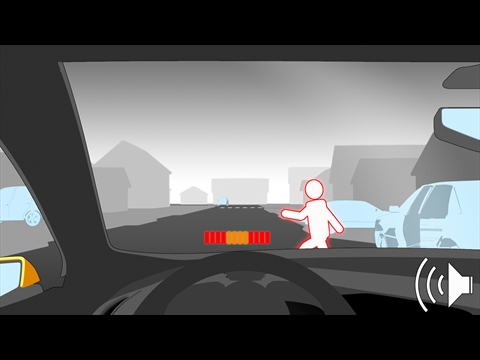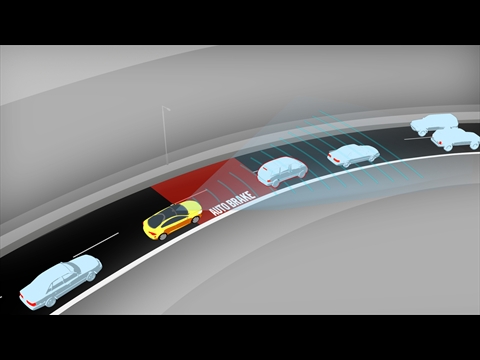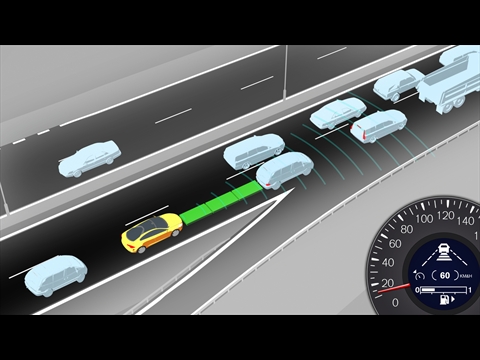

Photographs can be seen in our Volvo Gallery
Groundbreaking Volvo technology helps drivers avoid accidents with pedestrians
16 December 2008
Volvo Cars is now introducing the next generation of preventive safety technology. Collision Warning with Full Auto Brake and pedestrian detection reacts when a pedestrian walks out in front of a car - and will activate the car’s full braking power if the driver does not respond to the danger. This groundbreaking innovation is being presented in the Volvo S60 Concept, which is being unveiled for the first time at the Detroit Motor Show in early January 2009.
This safety innovation is the next step in Volvo Cars’ continuous development of technologies that detect dangerous situations and that actively help the driver avoid an accident.
"The previous stages were developed to help the driver avoid collisions with other vehicles. Now we are taking a giant step forward with a feature that also boosts safety for unprotected road-users. What is more, we are now advancing from fifty percent to full automatic braking power. To our knowledge, none of our competitors have made such progress in this area," explains Thomas Broberg, safety expert at Volvo Cars. He adds: "This technology helps us take an important step towards our long-term vision of designing cars that should not crash. Our aim for 2020 is that no one should be killed or injured in a Volvo car."
Accidents involving pedestrians common in urban traffic
Within the EU, the proportion of pedestrians figuring in overall traffic fatalities varies in between 10 and 25 percent depending on country. In the EU countries’ capital cities, 1,560 people died in road accidents in 2007. Of these, 43 percent were pedestrians.
The speed of the car involved in a collision with a pedestrian is of considerable significance to the outcome of the accident. Lowering the speed will help dramatically to reduce the risk of serious injury to the pedestrian. If speed drops from 50 km/h to 30 km/h, the chance of a pedestrian’s survival dramatically increases.
Avoids collisions at speeds below 20 km/h
"Our aim is that this new technology should help the driver avoid collisions with pedestrians at speeds below 20 km/h. If the car is being driven faster, the aim is to reduce the impact speed as much as possible. In most cases, we can reduce the collision force by about 75 percent," says Thomas Broberg. This technology is also highly beneficial in the event of rear-end impacts with other vehicles. Studies indicate that half of all drivers who drive into another vehicle from behind do not brake prior to the collision.
The main aim is still for the initial warning to be sufficient for the driver to brake or manoeuvre away from the hazard. Automatic braking is an emergency measure that is only activated when the collision is imminent. In such cases, Collision Warning with Full Auto Brake can help entirely avoid a collision if the relative speed difference between the two vehicles is less than 25 km/h.
Safer detection with state-of-the-art technology
Collision Warning with Full Auto Brake and pedestrian detection consists of a new, state-of-the-art dual-mode radar unit integrated into the car’s grille, a camera behind the inside rear-view mirror and a central control unit. The radar and camera continuously monitor the road in front of the car. The radar’s task is to detect objects and measure the distance to them. The camera’s function is to determine what type of objects they are.
The function is programmed to respond to cars in front that are at a standstill or moving in the same direction. Thanks to the state-of-the-art radar, which has a widened field of vision, the unit can also detect the moving pattern of a pedestrian.
"We’ve been working on this technology for ten years now. We have had test cars out on the roads for several years and we’ve driven in many different countries Factors like traffic scenarios, road conditions and climate should be considered in the design of the final system. We can also use the information from these tests to make advance computer simulations, to test and verify the system in different scenarios" says Thomas Broberg.
New technology permits full braking power
In an emergency situation, the driver first gets an audible warning together with a flashing light in the windscreen’s head-up display. In order to prompt an immediate, intuitive reaction, the visual warning is designed to look like a brake light coming on in front. If the driver does not respond to the warning and the system assesses that a collision is imminent, the car’s brakes are applied with full braking power.
"Active brake activation requires that the object is confirmed by both the radar and the camera. Thanks to the state-of-the-art sensors, it is now possible to engage full braking power. We are among the very first in the industry to achieve this," explains Thomas Broberg. The system is built along the same principles as the human eye and, just like our own eyes, vision is impaired in the dark and in poor weather.
Upgraded Adaptive Cruise Control
Volvo Cars’ Adaptive Cruise Control (ACC) has now been upgraded with a queue assist function. The radar-based Adaptive Cruise Control maintains the set time gap to the vehicle in front all the way down to standstill. Since the previous version was not active at speeds below 30 km/h, this means that this comfort-enhancing system becomes usable even in slow-moving queues with repeated starting and stopping. It should be emphasised that the upgraded ACC has been developed to enable comfortable driving with an automatic gearbox in normal circumstances.
Collision Warning with Full Auto Brake and pedestrian detection and the upgraded Adaptive Cruise Control will be introduced in the all-new Volvo S60 in 2010.



Legal | Privacy | Contact Us | Search | Site Map
Volvo Owners' Club Limited® 1962-2025

